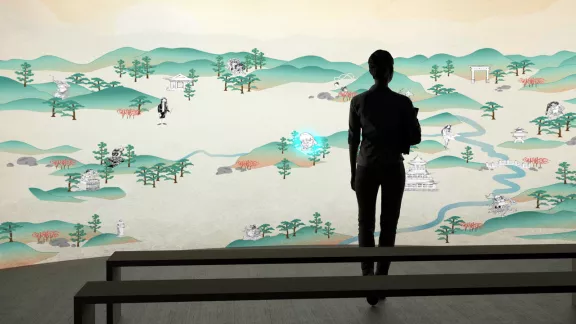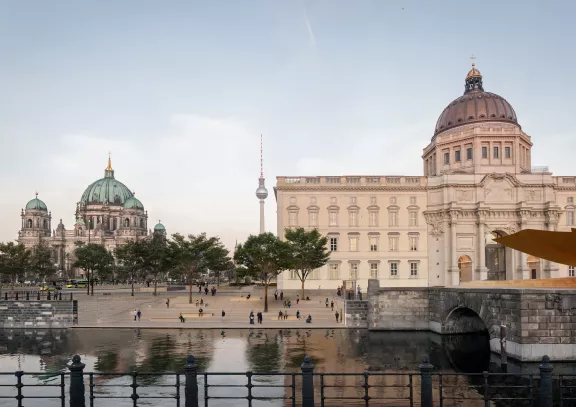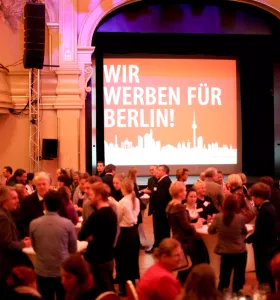Berlin’s new cultural heart
Cultural hub and historical centre
Berlin has always been renowned for its rich cultural life. Its centrepiece of the historical Mitte district is home to many outstanding sights – not just the Museum Island, but no less than two opera houses and six major theatres as well as innumerable galleries and arts venues. Now, a series of new cultural projects are being developed, often just a few minutes’ walk apart, lending a new quality to this fascinating district. Here, we offer an overview of major recent and planned cultural projects in the heart of Berlin.
Newly opened in 2022

Samurai Museum
Especially the district between Oranienburger Tor and Rosenthaler Platz is developing more vibrantly. Since May, the Samurai Museum presents one of the world’s largest collections of samurai art, weapons and artefacts outside Japan. On around 1500 square metres, works by contemporary Japanese artists will be shown together with the armour, helmets, masks and swords of these legendary warriors. The opening of the renowned Swedish photo museum "Fotografiska" in the former Tacheles is expected to follow next year.
"Stabi Kulturwerk" - The Museum of the Berlin State Library
The historic house of the Berlin State Library (Staatsbibliothek Berlin) Unter den Linden has also been extensively modernized in recent years and is now open to the public again. The Berlin State Library is one of the most important libraries in the world, and among other things, the original scores of Ludwig van Beethoven's famous 9th Symphony are kept there.
On 13 July, the "Stabi Kulturwerk", a new museum, was opened in the rooms of the State Library on Unter den Linden. In the future, permanent and temporary exhibitions will be shown there in an area of around 1,000 square meters.

Humboldt Forum: Berlin's new forum for culture is completed
A few months ago, Berlin's new forum for culture, art and science opened in the heart of Germany’s capital city. Since then, the Humboldt Forum has become a public favorite. In cutting edge interactive exhibitions, visitors can explore continents, regions, lifeworlds and ideas – on around 30,000 square metresacross five floors.
On the second and third floors, the Ethnological Museum and Asian Art Museum collections present precious art from Africa, Asia, Oceania and America. While previously only the rooms of the west wing were accessible, the east wings of both museums have also been open to the public since 17 September.
Future developments
Around the Humboldt Forum

Monument to Freedom and Unity
The Monument to Freedom and Unity is due to be inaugurated expected in the course of the year 2024. Set opposite the Humboldt Forum’s west portal, the 50-metre-long kinetic memorial is dedicated to the Peaceful Revolution and the fall of the Wall in 1989. In 2020, work started on the broad base to hold a gigantic bowl constructed of steel components. This walk-on ‘see-saw’ social sculpture is to be open to the public. When one half of the bowl has twenty people more on it than the other, the bowl will start to move, slowly and gently. The inauguration ceremony is scheduled for 2024.

The Schlossfreiheit staircase
At the Spree Canal’s waterside promenade in front of the Humboldt Forum’s west portal, the Schlossfreiheit, a vast 38-metre-wide open-air staircase, will be built over the next two years. The staircase is the first building phase of the Fluss Bad Berlin future project and scheduled to be completed in 2024.
Berlin’s Cathedral Church: Renovating the Hohenzollern Crypt
With ninety internments, the Hohenzollern Crypt in Berlin’s Cathedral Church(Berliner Dom) is the most important dynastic sepulchre in Germany. Reflecting stylistic eras in art history across several centuries, the richly decorated coffins and ornate sarcophagi are the last resting places of princes and kings from the Hohenzollern dynasty. The extensive refurbishment and conversion work includes a new information centre and making the crypt fully wheelchair accessible. A stronger focus will also be put on the historical links between the Hohenzollern crypt and the former Hohenzollern City Palace once standing on the nearby Humboldt Forum site. The Hohenzollern Crypt is scheduled to reopen in spring 2024.
German Historical Museum (DHM): Refurbishment of the Zeughaus
The baroque Zeughaus, originally an arsenal and now home to the German Historical Museum, is among the most impressive buildings on Berlin’s famous Unter den Linden boulevard. Today, the Zeughaus presents around 2000 years of German history. From mid-2021, the Zeughaus will be closed for around four years for a major renovation. The façade of the 300-year-old baroque building will be restored, and the interior given a modern air conditioning system. After completion of the work, the Zeughaus is set to reopen in late 2025. During the refurbishment, the Pei Building, the museum’s modern exhibition hall supplementing the historic Zeughaus, will remain open to the public.
The Pergamon Museum: Refurbishment of the Pergamon Altar Hall and the North Wing
Berlin’s Pergamon Museum (Pergamonmuseum)attracts more visitors than any other museum in the city. Under the Museum Island Master Plan, it is now being refurbished in a series of stages. The Roman monumental altar, nearly 2000 years old, is the heart of the museum. At present, the Pergamon Altar Hall and the North Wing, with other exhibits from the Collection of Classical Antiquities, are both closed. The original Pergamon Altar covered an area of around 1200 square metres. The sculpted pedestal frieze panels on show, each two-and-a-half-metres high, depict the spectacular battle between the Olympian gods and the Giants. In 2025, the refurbished and modernised Altar Hall and North Wing will be reopened. Until then, the Pergamon Museum. The Panorama, a 360-degree exhibition directly opposite the Museum Island, offers a fascinating taste of the Pergamon Altar experience.
Expanding the Cultural Forum (Kulturforum)
The Museum of the Twentieth Century
Over the coming years, the Museum of the Twentieth Century is to be constructed close to Potsdamer Platz in the heart of Berlin. Located between the New National Gallery (Neue Nationalgalerie) and Berlin’s renowned Philharmonic Hall, the new museum represents a major step towards completing the Kulturforum. After opening, the museum will have around 9000 square metres of exhibition space to show major works from the second half of the twentieth century. The museum has been designed by the Swiss architectural office Herzog & de Meuron. The striking interior design includes two intersecting boulevards inviting visitors to explore the museum. On two different levels, the boulevards run north-south and east-west, opening up diverse views of the exhibition rooms and the art works. The museum is scheduled to be completed in 2026.
Developments in Berlin’s historical core

The House of One
A new and unique multifaith centre, the House of One will be constructed on the old St. Peter’s Church site going back around 800 years to when Berlin was founded. Perfectly capturing the project’s vision, the new building by the Kuehn Malvezzi architectural office has a large central domed hall linking the prayer rooms of the three major monotheistic religions – a mosque, a synagogue, and a church. The House of One is a house of worship and interfaith dialogue between religious communities, a place of peaceful coexistence, tolerance, and mutual understanding. The festive groundbreaking ceremony is scheduled for 27 May 2021, and the building is expected to be completed in three to four years. The opening is scheduled for 2026.
„Petri Berlin. Discover archaeology“ – New archaeological house on Petriplatz square
With excavations on Petriplatz uncovering traces of the city’s history as a medieval settlement, the square is ideal for Berlin’s newvisitors centre for archaeological sites: „Petri Berlin. Discover archaeology“.. The interactive displays in the multi-story modern building take real-life examples to explain archaeological processes, from excavating an object to restoration and archiving. Uniquely, with the Archaeological House also an archaeological site under excavation, the archaeologists’ tasks can be presented in showcase workshops. The Archaeological House will not only also exhibit archaeological finds, but offer events and seminars in a vibrant forum of exchange between experts and the general public. The opening ceremony is scheduled for 2024.
Recent developments in Berlin’s new cultural centre
August 2021: Reopening National Gallery (Neue Nationalgalerie)
• After extensive modernisation, Mies van der Rohe’s renowned steel-and-glass construction is again showing twentieth-century masterpieces.
June 2021: ANOHA – The Children’s World of the Jewish Museum Berlin
• The new ANOHA Children’s World, directly across from the Jewish Museum Berlin, invites children of preschool and grade-school age to play, discover and think about life and the respectful coexistence of people, animals and nature.
• A gigantic circular wooden Noah’s Ark stands at the centre of the museum. Around 150 animal sculptures fly, stand or crawl in and around the ark, all created by selected artists using recycled materials and found objects. Various workshop rooms and studios provide space for children to become creative themselves, making music and putting on plays.
• ANOHA has also set up a Children’s Advisory Council. In regular meetings, the Council members put forward ideas and suggestions for interior designs and educational programmes, playing an active role in shaping the ANOHA’s present and future development.
October 2020: The Friedrichswerdersche Kirche reopens
• After comprehensive refurbishment, the Friedrichswerdersche Kirche (Friedrichswerder Church) reopened on 27 October 2020 as a branch of the Alte Nationalgalerie (Old National Gallery).
• Close to the new Humboldt Forum, this brick building was designed by Karl Friedrich Schinkel in a neo-gothic style and built from 1824 to 1830.
• The high lancet windows, some still with their original stained glass, flood the single nave interior with light, producing a perfect space to exhibit the Alte Nationalgalerie’s sculptures from 1800 – 1850.
September 2019: The Futurium opens
• Since September 2019, the Futurium – the House of Futures – has been inviting visitors to discover various possible futures in an entertaining look at how we want to live.
• On 3200 square metres of space, the exhibitions focus on topics and areas of our lives such as nutrition, energy, housing, and work. The Futurium Lab offers visitors a chance to test exciting inventions, for example, a 3D printer or a laser cutter. In Hackathons you can join teams to develop your own computer programmes, while at the Test Kitchen you can discover the possible foods of tomorrow.
• The Futurium building, designed by Berlin architects Richter and Musikowski, is low energy, climate-friendly, and fully accessible. Its high window fronts also offer panoramic views of the government quarter.
August 2019: Haus Bastian – Centre for Cultural Education
• In 2019, in the Museum Island’s direct vicinity, the Staatliche Museen zu Berlin festively opened this new location for educational work and outreach programmes. Intended for a large audience, Haus Bastian enables school groups, families, teenagers and adults to prepare for a museum visit in a creative and participative environment and discuss their insights and experiences afterwards.
• It also offers a forum for further education and meetings for professionals across a range of areas.
• Until 2019, the generous spaces of this four-storey building, designed by David Chipperfield, presented the art works of the renowned Bastian Gallery. The Bastian family generously gifted the building to the Staatliche Museen and opened a new gallery in Berlin-Dahlem in 2021.
July 2019: The James Simon Gallery opens
• Summer 2019 saw the opening of the Museum Island’s new central entrance, visitor centre, and temporary exhibition space. The light and transparent design by architect David Chipperfield translates the historical theme of colonnades into a modern form.
• The James Simon Gallery, a building phase in the Museum Island Master Plan agreed in 1999, leads visitors to the Pergamon Museum and over the basement level Archaeological Promenade to the Neues Museum.
• The new central entrance building is named after James Simon (1853–1932). This Berlin industrialist from a Jewish background generously transferred his extensive private collection, including the world-famous bust of Nefertiti, to the Museum Island museums.
October 2017: The Staatsoper Unter den Linden reopens
• The Staatsoper Unter den Linden was Berlin’s first free-standing opera house. Designed by architect Georg Wenzeslaus von Knobelsdorff and constructed from 1741 to 1743, the opera house was the largest in Europe in its day.
• In 2017, after seven years of extensive refurbishment and modernisation, the opera house celebrated its reopening, resplendent in all its former glory and with some discreet additions.
• The refurbishment included installing completely new stage equipment and raising the ceiling of the auditorium by four metres to create a ‘reverberation gallery’, adding one second to the auditorium’s reverberation time.
March 2017: Pierre Boulez Saal opens
• Opened in March 2017, the Pierre Boulez Saal is a major international concert hall. Initiated by Daniel Barenboim, General Music Director of the Staatsoper Unter den Linden, the hall was developed with the American architect Frank Gehry.
• The globally acclaimed acoustician Yasuhisa Toyota created the hall’s impeccable acoustics.
• This elliptical hall lined with light cedarwood has one very special feature – the audience and musicians are set close together and literally meet on eye level.
The text can be used in extracts or edited. Please indicate the copyright visitBerlin. Please forward sample copy to: presse@visitBerlin.de or visitBerlin | Pressestelle | Am Karlsbad 11 | D-10785 Berlin.
Infographics "Berlin's changing cultural heartland"
Infografik







